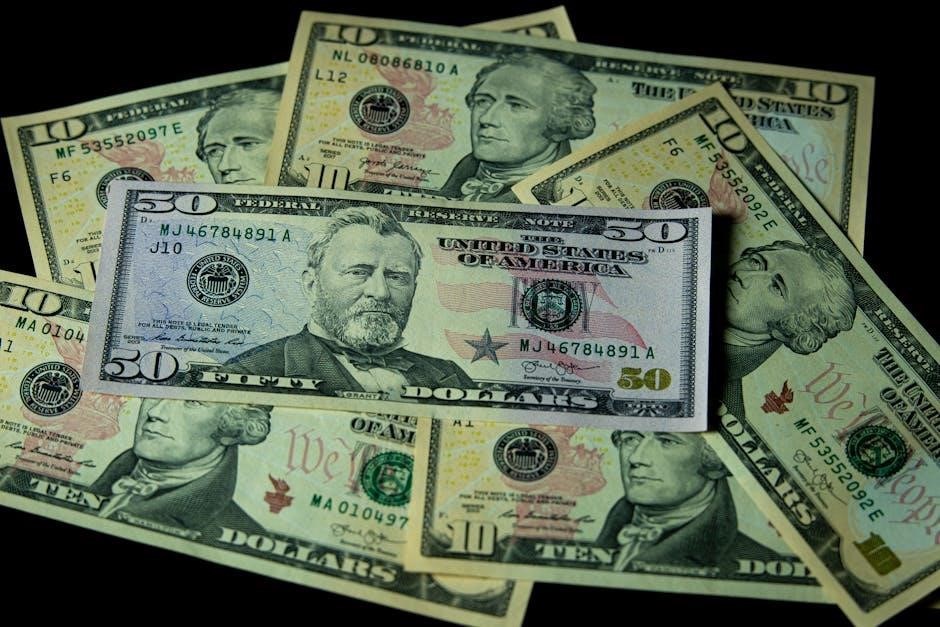The Bill of Exchange Act 1882 is a foundational UK law governing bills of exchange, cheques, and promissory notes, providing a legal framework for their use.
Available as a downloadable PDF, it outlines the rules and regulations for negotiable instruments, ensuring clarity and standardization in financial transactions under UK law.
1.1 Overview of the Act
The Bill of Exchange Act 1882 is a UK legislation that codified the law relating to bills of exchange, cheques, and promissory notes, providing a comprehensive framework for their creation, negotiation, and enforcement.
It standardizes the rules for negotiable instruments, ensuring legal clarity and consistency in financial transactions, and remains a key reference for understanding the legal aspects of bills of exchange in the UK.
1.2 Historical Context
The Bill of Exchange Act 1882 was enacted during the reign of Queen Victoria to modernize and clarify the law governing financial instruments like bills of exchange, cheques, and promissory notes.
It was a response to the growing complexity of commercial transactions in the 19th century, aiming to provide a uniform legal framework for both inland and foreign bills, ensuring consistency and reducing disputes in trade and finance.
1.3 Purpose and Scope
The Bill of Exchange Act 1882 aims to codify and regulate the use of bills of exchange, cheques, and promissory notes, ensuring legal certainty and standardization.
Its scope extends to defining key terms, outlining requirements for validity, and establishing procedures for negotiation, endorsement, and dishonor, thereby facilitating efficient and secure financial transactions in the UK.

Key Definitions Under the Act
The Act defines a bill of exchange as an unconditional written order to pay a specified sum, addressing key terms like inland and foreign bills and negotiability.
2.1 Definition of a Bill of Exchange
A bill of exchange is defined under the Act as an unconditional written order from one party (the drawer) to another (the drawee), directing the payment of a specified sum to a third party (the payee) or their order. It must be in writing, signed by the drawer, and addressed to a named drawee. The sum payable must be certain, and the instrument must be delivered with the intention of creating a legal obligation. This definition establishes the legal framework for its use as a negotiable financial instrument under UK law.
2.2 Types of Bills: Inland and Foreign
An inland bill is one where the payee is to be paid within the same country, typically in the UK, and is governed by the Act’s provisions. Foreign bills, however, involve parties in different countries, with payment made abroad. Both types must adhere to specific legal requirements, though foreign bills may require additional documentation or compliance with international laws. The distinction is crucial for determining jurisdiction, applicable laws, and procedural requirements under the Act.
Inland bills simplify transactions due to uniform legal standards, while foreign bills introduce complexities like currency exchange and varying regulatory frameworks. The Act ensures clarity for both, maintaining consistency in their legal treatment while addressing unique challenges for international transactions.
2.3 Negotiable and Non-Negotiable Bills
A negotiable bill of exchange is transferable and can be passed from one party to another, granting the holder the right to claim payment. Non-negotiable bills, however, are not transferable and are only valid between the original parties involved. The Act defines negotiable bills as those payable to order or bearer, while non-negotiable bills lack this flexibility and legal protection.
Negotiable bills provide greater liquidity and are widely used in commerce, whereas non-negotiable bills are limited in their application. The distinction is essential for understanding the rights and obligations of parties involved in financial transactions under the Act.
Structure of the Bill of Exchange Act 1882
The Act is divided into parts, beginning with preliminary sections, followed by main provisions, and concluding with amendments and revisions to ensure clarity and applicability.
3.1 Preliminary Sections
The preliminary sections of the Bill of Exchange Act 1882 establish essential definitions and interpretations, providing a framework for understanding key terms such as “bill of exchange,” “inland and foreign bills,” and “negotiable instruments.” These sections set the scope and application of the Act, ensuring clarity for legal and financial practices. They also outline the short title and commencement, making the legislation accessible and enforceable under UK law. This foundational part is crucial for interpreting subsequent provisions effectively.
3.2 Main Provisions
The main provisions of the Bill of Exchange Act 1882 outline the legal requirements for bills of exchange, cheques, and promissory notes; These provisions ensure that such instruments are valid and enforceable, detailing the essential elements, such as being in writing, containing an unconditional order to pay, and specifying the sum payable. The Act also addresses the negotiability of bills, distinguishing between bills payable to order or bearer, and the implications of endorsements. These sections establish the framework for understanding the rights and liabilities of parties involved in such financial transactions under UK law.
3.3 Amendments and Revisions
The Bill of Exchange Act 1882 has undergone several amendments to align with modern financial practices. Key revisions include the integration of electronic bills of exchange under the Electronic Trade Documents Act 2023, recognizing digital signatures as valid. Additionally, updates have clarified rules for cross-border transactions and enhanced provisions for dishonored bills. These revisions ensure the Act remains relevant, addressing contemporary issues in global trade and digital commerce while maintaining its foundational principles. The Act continues to evolve, reflecting technological advancements and international legal standards.
Essential Requirements for a Bill of Exchange
A bill of exchange must be in writing, unconditional, and clearly state the amount, currency, and payment terms. It must also name the drawee and specify a definite payment date.
4.1 Form and Content
The Bill of Exchange Act 1882 mandates that a bill of exchange must be in writing and contain an unconditional order to pay a specified sum. It must include the amount, currency, and payment terms, as well as the drawee’s name and a definite payment date or indication of when payment is due.
The bill must also be signed by the drawer and addressed to the drawee. It must be delivered to the drawee or holder to be valid. The payee must be clearly named or indicated with reasonable certainty to ensure the instrument’s negotiability and legal enforceability under the Act.
4.2 Certainty Required as to Payee
The Bill of Exchange Act 1882 stipulates that the payee must be named or indicated with reasonable certainty to ensure the bill’s validity and negotiability. This clarity is essential for identifying the rightful recipient of payment, preventing disputes, and maintaining the integrity of the financial instrument. Ambiguity regarding the payee can render the bill unenforceable, as it undermines the legal certainty required for its negotiation and transfer under the Act.
4.3 Sum Payable and Currency
The Bill of Exchange Act 1882 mandates that the sum payable must be clearly specified in the bill, either in words or figures, to ensure clarity and prevent disputes. The currency in which the payment is to be made must also be explicitly stated. If the sum or currency is ambiguous or missing, the bill may not be considered negotiable, as certainty regarding the payment amount and denomination is fundamental to its validity under the Act.

Negotiation and Transfer of Bills
The Bill of Exchange Act 1882 governs the negotiation and transfer of bills, ensuring legal clarity on endorsement, delivery, and the rights of holders in financial transactions.
5.1 Endorsement and Delivery
Endorsement and delivery are critical processes under the Bill of Exchange Act 1882, ensuring the legal transfer of bills. Endorsement involves the payee signing the bill to transfer rights, while delivery completes the transfer. Proper endorsement and delivery are essential for maintaining negotiability, as outlined in the Act. These processes ensure the holder gains valid title, facilitating smooth financial transactions under UK law. The Act specifies requirements for both, ensuring clarity and legal certainty in the transfer of bills of exchange.
5.2 Holder in Due Course
A holder in due course under the Bill of Exchange Act 1882 is a party who acquires a bill of exchange in good faith, for value, and before it becomes overdue. This status protects the holder from defects in the title of prior holders and ensures they can enforce payment free from defenses. The Act emphasizes the importance of good faith and lack of notice of any issues, making the holder in due course a key concept in maintaining the integrity and negotiability of bills of exchange under UK law.
5.3 Rights of the Holder
The holder of a bill of exchange has the right to enforce payment and may seek damages if the bill is dishonored. Under the Act, the holder is entitled to receive payment on the due date without unnecessary delay or condition; If the bill is dishonored, the holder can recover damages, including interest and costs. The rights of the holder are protected against defenses that may arise from prior transactions, ensuring the holder’s entitlement to payment remains secure under the provisions of the Bill of Exchange Act 1882.

Dishonor and Protest of Bills
Dishonor occurs when a bill is refused acceptance or payment, entitling the holder to claim damages. Protest involves formal documentation of dishonor, necessary for legal action.
6.1 Reasons for Dishonor
A bill is dishonored if it is refused acceptance or payment due to insufficient funds, irregularities, or non-compliance with terms. Reasons include non-acceptance by the drawee, lack of funds, or invalid signatures. Additionally, if the bill is post-dated, ante-dated, or bears a Sunday date, it may be dishonored. The drawer’s death, insanity, or insolvency can also lead to dishonor. Such instances nullify the bill’s negotiability, and the holder may seek legal recourse for recovery of the amount due.
6.2 Consequences of Dishonor
Dishonor of a bill results in the termination of the drawer’s and endorsers’ liability, transferring the burden to the holder. The holder may sue for damages, including the principal sum, interest, and charges. Dishonor also affects the creditworthiness of the drawer and drawee, potentially damaging their financial reputation. Legal actions can be taken against the parties involved, ensuring accountability for non-payment. This underscores the importance of compliance with the Act’s provisions to avoid adverse legal and financial repercussions for all parties implicated in the transaction.
6.3 Protest Procedures
When a bill is dishonored, protest procedures must be followed to formalize the non-payment. A notary public typically notifies the drawer and parties involved. If no response is received, the bill is deemed protested. The protest note details the dishonor and is essential for legal action. Failure to protest may extinguish the holder’s rights to recover damages, emphasizing the importance of adhering to these formalities under the Act to preserve legal recourse for non-payment of the bill of exchange.

Legal Implications and Damages
The Act specifies recoverable damages upon dishonor, including interest and charges, ensuring compensation for non-payment while replacing additional claims, thus finalizing liability under the bill of exchange.
7.1 Liability of Parties
Under the Act, parties to a bill of exchange, including the drawer, drawee, and endorser, are held liable for payment if the bill is dishonoured. The drawer is primarily liable, while endorsers assume secondary liability. The holder of the bill may seek recovery from any party, ensuring a clear chain of responsibility. This framework provides legal certainty, protecting the rights of all parties involved in the transaction and ensuring compliance with the Act’s provisions. Liability is strictly defined to maintain fairness and accountability.
- Drawer: Primary liability for payment.
- Drawee: Liable if the bill is accepted but not paid.
- Endorser: Guarantees payment if the bill is dishonoured.
7.2 Damages and Compensation
Upon dishonour of a bill, the holder is entitled to recover damages, including the principal sum, interest, and reasonable expenses incurred. The Act specifies that damages replace interest and other charges, simplifying recovery processes. Compensation is calculated based on the bill’s terms and any losses suffered due to non-payment, ensuring fair reparation for the holder. This provision underscores the Act’s commitment to protecting parties’ rights and maintaining financial integrity in transactions.
- Damages cover the principal sum and interest.
- Expenses related to dishonour are recoverable.
- Compensation is designed to prevent further losses.
7.3 Interest and Charges
The Bill of Exchange Act 1882 outlines provisions for interest and charges related to dishonoured bills. Interest is recoverable on the principal sum, calculated from the date of dishonour. Additional charges, such as protest fees and notary expenses, may also be claimed. The Act ensures that holders can recover reasonable costs incurred due to non-payment, balancing the rights of all parties involved. These provisions aim to mitigate financial losses and uphold the integrity of transactions governed by the Act.
- Interest is recoverable on the principal sum.
- Additional charges include protest and notary fees.
- Provisions aim to balance rights and mitigate losses.

Special Provisions for Cheques and Promissory Notes
The Act treats cheques and promissory notes as negotiable instruments, with specific rules ensuring their validity and enforceability under UK law, distinct from general bills of exchange.
8.1 Cheques Under the Act
Cheques are defined as bills of exchange drawn on a banker, payable on demand. The Act specifies that cheques must comply with the general requirements for bills of exchange, including certainty as to the payee and a fixed sum payable. Cheques are considered negotiable instruments, and their dishonor entitles the holder to recover damages. The Act also addresses the rights of the holder and the liabilities of the drawer and drawee, ensuring legal clarity and protection for all parties involved in cheque transactions under UK law. The provisions are detailed in the downloadable PDF version of the Act.
8.2 Promissory Notes Defined
Promissory notes are unconditional written promises to pay a specified sum. Under the Act, they are distinct from bills of exchange as they do not require acceptance. A promissory note must be in writing, contain an unconditional promise to pay, and specify the amount, currency, and payee. It is not negotiable unless payable to order or bearer. The Act ensures legal clarity, defining the rights and obligations of issuers and holders, and is detailed in the downloadable PDF version of the Bill of Exchange Act 1882.
8.3 Legal Distinctions
The Act establishes clear legal distinctions between cheques, promissory notes, and bills of exchange. Cheques are defined as a type of bill of exchange drawn on a banker, payable on demand. Promissory notes differ as direct promises to pay, not requiring acceptance. These distinctions affect negotiability, transfer, and legal obligations. The Act ensures clarity in their legal treatment, outlined in detail within the downloadable PDF version, providing a comprehensive understanding of their roles in financial transactions under UK law.

Modern Relevance and Electronic Bills
The Bill of Exchange Act 1882 has evolved with modern technology, now addressing electronic bills and digital signatures, ensuring relevance in contemporary financial transactions and legal frameworks.
9.1 Electronic Bills of Exchange
Electronic bills of exchange, enabled by the Electronic Trade Documents Act 2023, modernize traditional financial instruments under the Bill of Exchange Act 1882.
These digital documents maintain legal validity, ensuring seamless transactions in a modern economy while adhering to updated regulatory frameworks that recognize electronic signatures and records.
9.2 Digital Signatures and Validity
Digital signatures on electronic bills of exchange are recognized as legally valid under the updated framework, ensuring authenticity and enforceability in digital transactions.
This modern approach replaces traditional handwritten signatures, leveraging encryption technology to maintain the integrity and security of financial documents, aligning with the Electronic Trade Documents Act 2023.
9.3 The Electronic Trade Documents Act 2023
The Electronic Trade Documents Act 2023 modernizes the legal framework for electronic trade documents, including bills of exchange, enabling their digital creation and transfer.
It complements the Bill of Exchange Act 1882 by recognizing electronic versions as legally valid, ensuring seamless integration into modern financial systems and international trade practices.
International Aspects and Comparisons
The Bill of Exchange Act 1882 influences international trade, with similar laws adopted globally, ensuring standardized practices across jurisdictions and aligning with global financial regulations and standards.
10.1 Bills of Exchange in Different Jurisdictions
Bills of exchange are recognized globally, with jurisdictions adopting similar principles from the UK Act. Countries like the United States, Canada, and Australia have enacted their own legislation, such as the Uniform Commercial Code (UCC) in the U.S., which governs negotiable instruments, including bills of exchange. These laws share common principles, such as the requirement for a written, unconditional order to pay, ensuring consistency in international trade.
However, variations exist, such as the Canadian Bills of Exchange Act, which mirrors the UK Act but includes specific provisions for electronic instruments. Such adaptations reflect local legal systems while maintaining alignment with international standards, facilitating cross-border transactions and legal certainty.
10.2 International Law and Standards
International law and standards harmonize the use of bills of exchange across borders, ensuring consistency in global trade. The Geneva Convention of 1930 established uniform rules for bills of exchange and promissory notes, adopted by many countries. Additionally, the United Nations Commission on International Trade Law (UNCITRAL) provides a model law on international credit transfers, aligning practices worldwide. While the UK Act influences global frameworks, local adaptations exist, such as the U.S. Uniform Commercial Code (UCC), reflecting shared principles while accommodating jurisdictional needs. These standards facilitate seamless cross-border transactions and legal certainty.
10.3 Cross-Border Transactions
Cross-border transactions involving bills of exchange are facilitated by international agreements and harmonized standards. The UK Act aligns with global practices, enabling seamless trade across jurisdictions. Electronic bills, as recognized by the Electronic Trade Documents Act 2023, further enhance efficiency in international dealings. These digital solutions ensure compliance with both domestic and foreign laws, reducing complexities in global commerce. The integration of digital signatures and electronic verification systems has modernized cross-border transactions, making them faster and more secure while maintaining legal validity under the Act.

Case Studies and Legal Precedents
Case studies and legal precedents illustrate the practical application of the Act, highlighting key judicial decisions that have shaped its interpretation and enforcement in real-world scenarios.
11.1 Notable Cases Involving Bills of Exchange
Notable cases, such as those involving dishonor and endorsement, highlight judicial interpretations of the Act. Courts have ruled on issues like liability, transfer, and payment disputes, shaping legal precedents; These decisions emphasize the importance of compliance with the Act’s provisions, ensuring fairness and clarity in financial transactions. Key rulings often address ambiguities in bill drafting, demonstrating the practical application of the legislation. Such cases serve as benchmarks for resolving disputes and interpreting the Act’s nuances in modern legal contexts.
11.2 Impact of Judicial Decisions
Judicial decisions have significantly shaped the interpretation and application of the Bill of Exchange Act 1882. These rulings clarify uncertainties, establish precedents, and guide future transactions. Courts have addressed issues like liability, dishonor, and endorsement, ensuring consistency in legal outcomes. Such decisions not only resolve disputes but also influence the rights and obligations of parties involved, fostering predictability in financial dealings. The impact of these judgments underscores the dynamic nature of the legal system in adapting to evolving financial complexities and ensuring fairness in commercial interactions governed by the Act.
11.3 Practical Applications
The Bill of Exchange Act 1882 has wide-ranging practical applications in modern commerce. It provides a legal framework for secure and efficient transactions, ensuring clarity in the use of bills, cheques, and promissory notes. Businesses rely on this Act to facilitate domestic and international trade, while courts use it to resolve disputes. Its provisions protect both drawers and holders, ensuring consistency and fairness. Compliance with the Act is essential for avoiding legal complications, making it a cornerstone of financial transactions and a key tool for maintaining trust in commercial dealings.
The Bill of Exchange Act 1882 remains a cornerstone of UK financial law, providing clarity and structure for negotiable instruments; Its principles continue to guide modern commerce.
12.1 Summary of Key Points
The Bill of Exchange Act 1882 codified UK law on bills of exchange, cheques, and promissory notes, providing a clear legal framework for financial transactions. It defined key terms, such as bills of exchange, and distinguished between inland and foreign bills. The Act outlined requirements for negotiability, dishonor, and liability, ensuring certainty and fairness. Its provisions have been updated to accommodate modern financial practices, including electronic bills and international trade. This Act remains a fundamental reference for understanding negotiable instruments in UK law and commerce.
12.2 Future Developments
The future of the Bill of Exchange Act 1882 lies in its adaptation to digital advancements and global trade evolution. The Electronic Trade Documents Act 2023 already enables electronic bills, aligning the law with modern commerce. Further developments may include expanded use of digital signatures, blockchain for enhanced security, and international harmonization of regulations. As technology progresses, the Act will likely evolve to accommodate emerging financial instruments and ensure efficiency in cross-border transactions, maintaining its relevance in a rapidly changing global economy while preserving its core principles of clarity and fairness.
